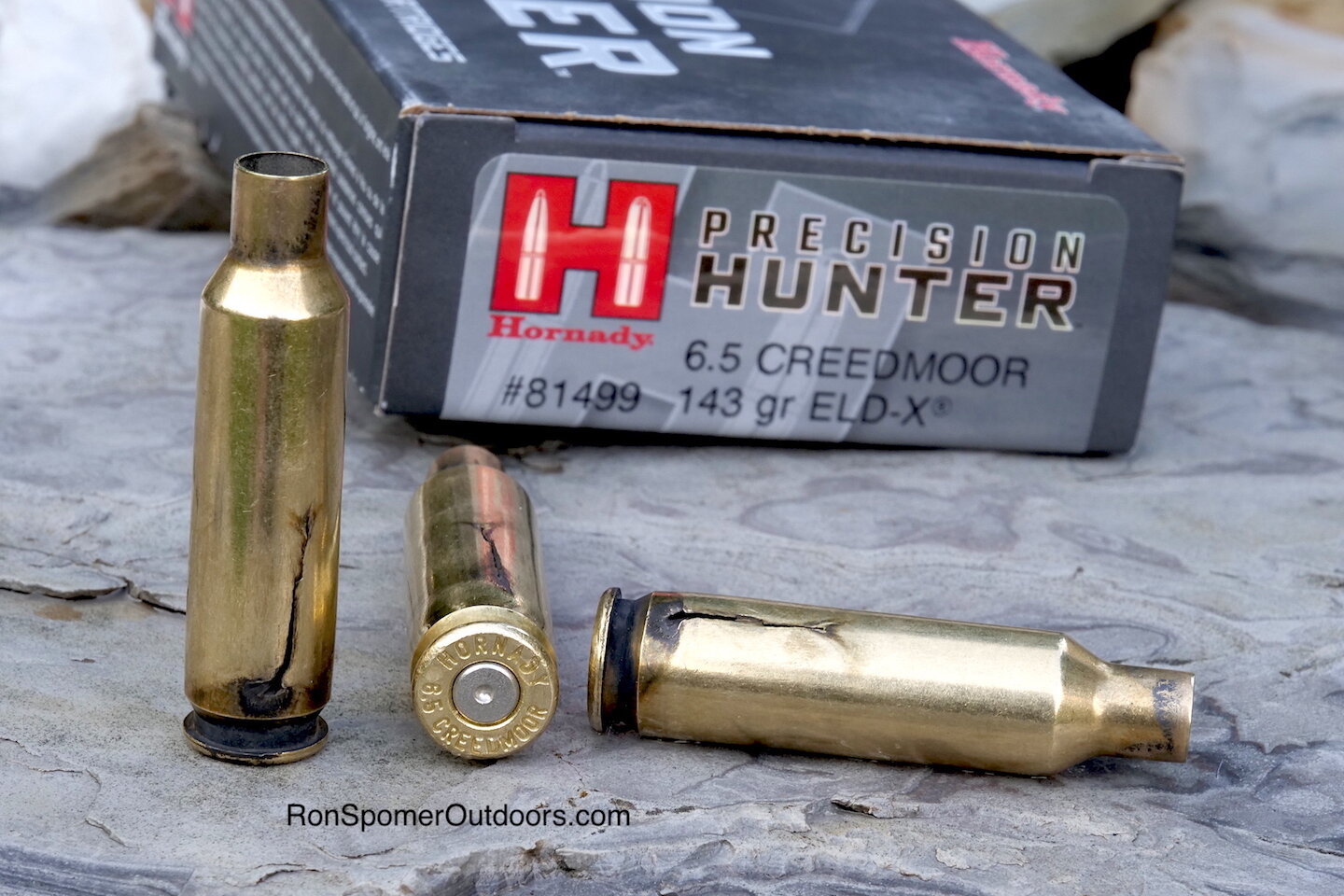The Creedmoor Explodes
When you read a title like The Creedmoor Explodes, you don’t take it literally. But in this case you should. Because, as the accompanying photo shows, the brass cases of these Hornady 6.5 Creedmoor cases did explode.
Well, rupture is the more accurate term. But let’s not nit pick. Anytime you eject a fired case to discover a breach (pun intended) like this, you have a problem.
Photo shows three brass 6.5 Creedmmor cases with bodies split open.
Most of us have been warned about over-charged handloads or shooting the wrong cartridge in a firearm. Split barrels, exploding actions, bolts flying back in your face, etc. Such things can happen, which is why rifles are engineered to withstand considerably more gas pressures than modern cartridges produce. As you might imagine, quite a bit of safety tolerance or “fudge factor” is built into the systems, everything from extra strong steel and gas blocks in the bolt raceways to gas shrouds on the ends of the bolt body and escape vents (those holes in the front receiver rings.)
In this case of the 6.5 Creedmoor Explodes, those all worked. The shooter didn’t discover the ruptured cases until after several had been fired and he was policing the brass from the shooting venue. His first thought was to condemned the brass cases, but before we roll with that and pass judgement, let’s consider the mechanics and engineering of a rifle. Aside from weak or thin brass, what could make a case like this rupture?
Let’s recall that at one time all rifles shot caseless ammo, so brass isn't critical to proper functioning. You poured powder down the muzzle, rammed a bullet atop it, and fired away. We called these muzzleloaders. The absence of a case wasn’t a problem because the rifle breech was solid steel. Aside from the flash hole on the side of the breech, there was no route for gases to travel back toward the shooter.Breech loaders changed all that. The brass case was invented to contain the powder and hold the bullet, a convenient package for rapid loading. But that left gaps through which powder gases could jet back into the shooter’s face. This was prevented by the malleable brass itself. Heat and pressure made it expand tightly against the chamber's walls, sealing it quite effectively during the split second required for the bullet and gases to escape forward. Instantly the brass rebounded and cooled enough to loosen its grip on the chamber walls for easy extraction.
In the early days of smokeless power — especially Cordite in hot climates like Africa and India — excessive pressures led to failed extraction. Overheated, overly pressured brass cases expanded so much that they couldn’t easily be pulled from the chamber. But they didn’t necessarily rupture. Why not? Because the tight chamber dimensions prevented it.
That’s the key to this little mystery. Either the 6.5 Creedmoor brass was excessively undersized or the chamber of the rifle was excessively oversized or, in this case mis-sized. We’re going with the latter assumption because another rifle on the line shooting the same lot of 6.5 Creedmoor cartridges had no rupture problems.
In this photo notice the consistency of the ruptures. Same place, same shape, same length. This all suggests the rifle’s chamber was improperly reamed. How could that have happened? Misalignment of the spindles, probably. Instead of spinning precisely on center, it was wobbling enough to cut more of an egg shaped cylinder than a round one. The slight bulge in one spot created enough space for the brass to expand beyond its plasticity limit, so it split.
This was a well built, highly respected factory rifle and factory ammunition. It shouldn’t have happened, but it did. The built-in safety systems worked as they were supposed to, so no one was injured. The rifle went back to the factory for barrel replacement. I suspect and certainly hope that the manufacturer got a strong reminder to more carefully check its production for tolerances and quality control.
The author has witnessed incidents of case head separation, neck splitting, shoulder splitting and, now, case splitting, but (knock on wood) no injuries from these mishaps. He's an advocate of always wearing safety glasses as well as hearing protection when shooting.






